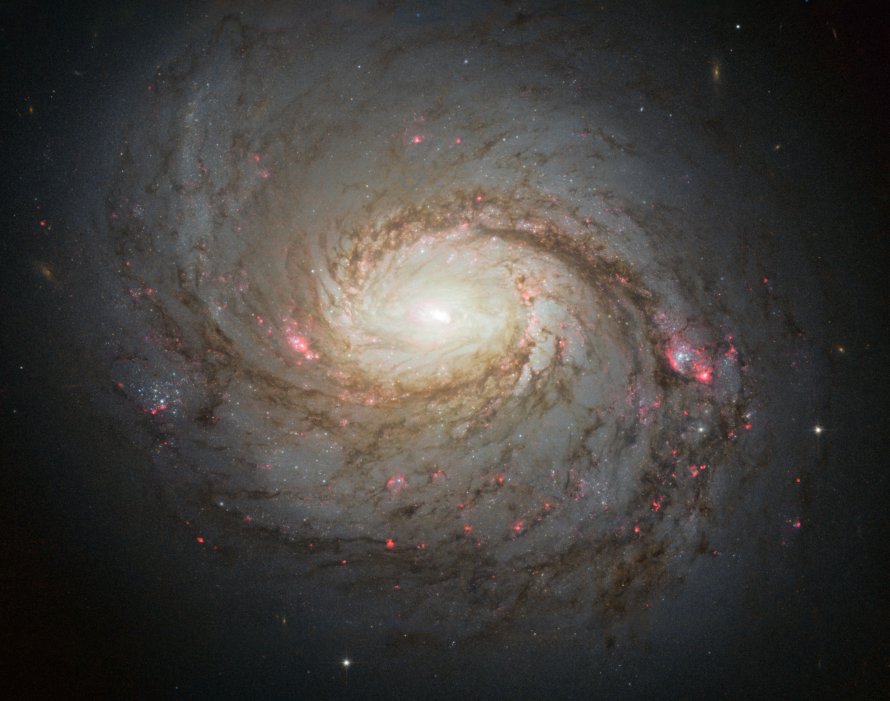M77 (NGC 1068) - Cetus A
Messier 77 (NGC 1068), also known as the Cetus A, is a spiral galaxy located in the constellation Cetus in the M77 Group of galaxies. M77 is 47000000 light years away from Earth.
M77 is best viewed during early spring, is magnitude 9.6, and can be viewed with small telescope. M77 is 7' x 6' in apparent size. For reference, the full moon is 30'.
Observing difficulty: Hard
- Name:
- Cetus A
- Type:
- spiral galaxy
- Constellation:
- Cetus
- NGC or IC:
- NGC 1068
- Magnitude:
- 9.6
- Viewing:
- small telescope
- Size:
- 7' x 6'
- Distance (light years):
- 47000000 LY
- RA:
- 2h 42.7m
- Dec:
- -9 2'
- Season:
- early spring
- Galaxy group:
- M77 Group
- Messier Marathon #:
- 1
* The naked eye can see up to magnitude ~7-8 objects under ideal dark sky conditions.
An Introduction to the Cetus A Spiral Galaxy
Messier 77, also known as M77 or NGC 1068, is a barred spiral galaxy located in the constellation Cetus, the Whale. The galaxy was discovered by the French astronomer Pierre M?chain in 1780 and later catalogued by Charles Messier. M77 is one of the largest and brightest galaxies in Messier's catalogue and is notable for being an active Seyfert Type II galaxy, indicating an active galactic nucleus (AGN) at its center.
Characteristics of M77
M77 is a remarkable astronomical object for a number of reasons. It exhibits a clear barred spiral structure, with two distinct 'arms' of stars and interstellar matter spiralling out from a bright, central bar. At its core, M77 houses an active galactic nucleus, characterized by intense emission of light across a broad range of wavelengths, from radio waves to X-rays. This is likely due to the presence of a supermassive black hole at the galaxy's center, which is actively accreting matter and spewing out large amounts of energy.
The overall structure and the characteristics of M77 make it an important object of study for astronomers seeking to understand the behavior of active galaxies and the dynamics of spiral galaxies.
Magnitude and Size
Messier 77 has an apparent magnitude of 9.6, which makes it visible through small telescopes from dark sky locations. It spans approximately 7.1 x 6.0 arc minutes in size, which corresponds to a linear diameter of about 170,000 light-years, making it one of the larger galaxies in Messier's catalogue. The galaxy is situated approximately 47 million light-years away from Earth.
Finding and Viewing M77
Finding M77 involves locating the constellation of Cetus, which is best viewed during the months of October, November, and December in the Northern Hemisphere. Cetus is found just to the southeast of the constellation Aries and to the northeast of Eridanus.
Once you have located Cetus, look for the star delta Ceti, which is the fourth brightest star in the constellation. M77 is situated just a few degrees to the southeast of this star. Given its relatively high magnitude, a small telescope or even binoculars under dark skies should be sufficient to observe M77. It will appear as a small, faint patch of light.
Higher magnifications and larger telescopes can reveal more details, including the bright central region and perhaps a hint of the barred spiral structure. The full structure and beauty of M77 can best be appreciated through long-exposure astrophotography.
In conclusion, Messier 77 is a fascinating object for astronomers and stargazers alike. While it may require a bit of effort to locate and observe, its unique characteristics and the potential to see an active galactic nucleus in action make it well worth the effort.



